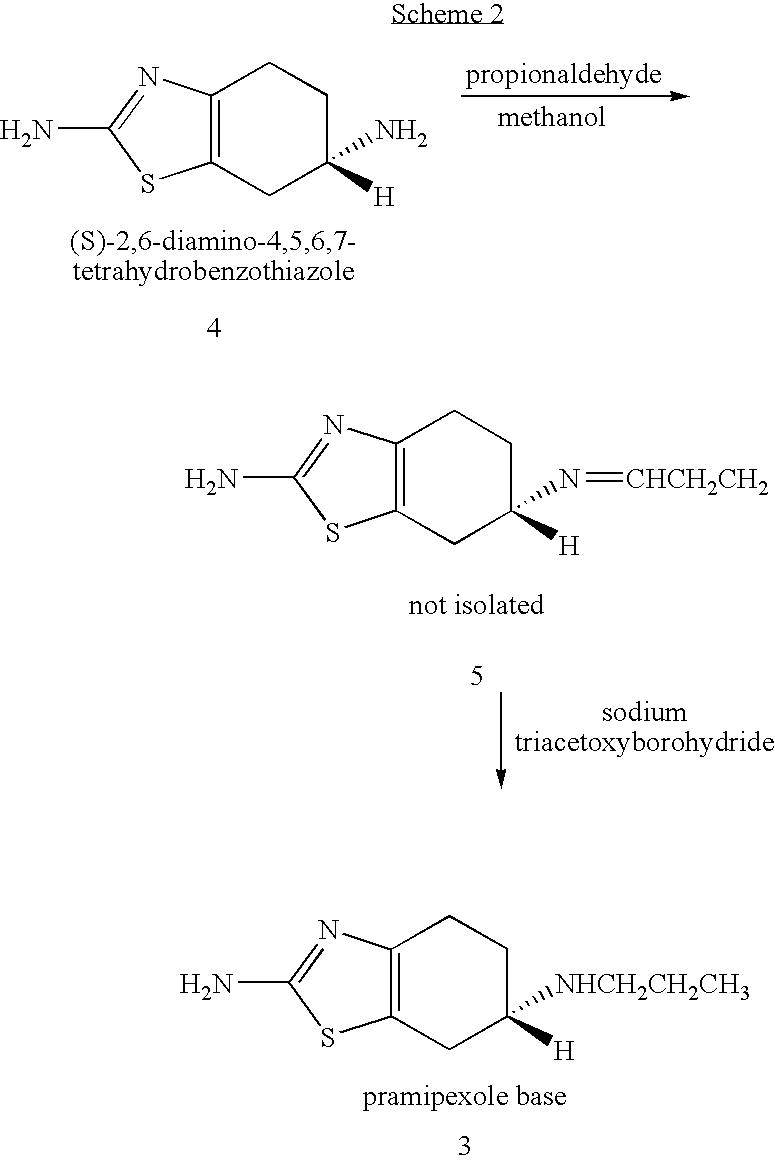Novel process for preparing pramipexole and its optical isomeric mixture by reduction with sodium triacetoxyborohydride
a technology of optical isomeric mixture and sodium triacetoxyborohydride, which is applied in the direction of biocide, organic chemistry, drug compositions, etc., can solve the problems of thermal instability of the reagent, increase in the assay cost, and increase in the amount of reagents
- Summary
- Abstract
- Description
- Claims
- Application Information
AI Technical Summary
Benefits of technology
Problems solved by technology
Method used
Image
Examples
example 1
[0067] A reaction vessel equipped with a magnetic stirrer and a thermometer was charged with (S)-2,6-diamino-4,5,6,7-tetrahydrobenzothiazole (5.0 g, 0.0296 mole) and methanol (100 ml) and the solution was cooled to 5° C. under constant stirring. A solution of propionaldehyde (2.7 ml) in methanol (10 ml) was added while maintaining the inner temperature at 5° C. The reaction mixture was stirred at this temperature for 15 minutes. Sodium triacetoxyborohydride (8.75 g, 0.0413 mole) was added in 4-5 portions while maintaining the temperature at 5° C. Stirring was continued at 5° C. for 5 minutes and the mixture was allowed to warm to 25° C. during about 30 minutes.
[0068] A mixture of water (100 ml) and 32% HCl solution (30 ml) was added to the reaction mixture to afford a suspension. The reaction mixture was evaporated to dryness under reduced pressure keeping the bath temperature at less then 50° C. Water (20 ml) and ethyl acetate (60 ml) were added to afford a two-phase system, and 4...
example 2
[0071] A reaction vessel equipped with a magnetic stirrer and a thermometer was charged with (R,S)-2,6-diamino-4,5,6,7-tetrahydrobenzothiazole (5.0 g, 0.0296 mole) and methanol (100 ml) and the solution was cooled to 5° C. under constant stirring. A solution of propionaldehyde (2.7 ml) in methanol (10 ml) was added while maintaining the inner temperature at 5° C. The reaction mixture was stirred at this temperature for 15 minutes. Sodium triacetoxyborohydride (8.75 g, 0.0413 mole) was added in 4-5 portions while maintaining the temperature at 5° C. Stirring was continued at 5° C. for 5 minutes and the mixture was allowed to warm to 25° C. during about 30 minutes.
[0072] A mixture of water (100 ml) and 32% HCl solution (30 ml) was added to the reaction mixture to afford a suspension. The reaction mixture was evaporated to dryness under reduced pressure keeping the bath temperature at less then 50° C. Water (20 ml) and ethyl acetate (60 ml) were added to afford a two-phase system, and...
example 3
[0075] A reaction vessel equipped with a magnetic stirrer was charged with pramipexole base (2.53 g) and absolute ethanol (20 ml). The mixture was stirred at room temperature to afford a clear solution. The solution was filtered and the filtrate was transferred to another reaction vessel. A solution of about 14.6% HCl in 2-propanol (7.8 ml) was added in portions and the resulting mixture was stirred for 1 hour. The mixture was cooled to about 5° C. and stirred for additional 1 hour. The precipitate was filtered, washed with cold ethanol and dried at 60° C. under vacuum to yield 3.0 g (89%) of pramipexole dihydrochloride.
PUM
| Property | Measurement | Unit |
|---|---|---|
| Temperature | aaaaa | aaaaa |
| Temperature | aaaaa | aaaaa |
| Temperature | aaaaa | aaaaa |
Abstract
Description
Claims
Application Information
 Login to View More
Login to View More - R&D
- Intellectual Property
- Life Sciences
- Materials
- Tech Scout
- Unparalleled Data Quality
- Higher Quality Content
- 60% Fewer Hallucinations
Browse by: Latest US Patents, China's latest patents, Technical Efficacy Thesaurus, Application Domain, Technology Topic, Popular Technical Reports.
© 2025 PatSnap. All rights reserved.Legal|Privacy policy|Modern Slavery Act Transparency Statement|Sitemap|About US| Contact US: help@patsnap.com



